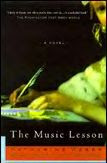> I liked The Music Lesson quite a bit. I wasn’t really aware of Katharine Weber until I heard her read from her new book, Triangle, at the Virginia Festival of the Book. I liked what I heard there and bought that book, and kept my eye out for her earlier books. I found this one in a local used book store and read it this weekend–it goes fast. One of the interesting things about it is its conceit. Sometimes when you read a novel you are meant NOT to ask the question, why is the narrator telling this story, or why are these words on the page. It’s just a story, you’re supposed to read it and not ask stupid questions. But I know it’s useful to the storyteller to know what the approach to the audience is, or the “conceit,” and so when I read a novel, and sometimes when I read a short story, I also want to know. Who’s telling this story, to whom, and why?
I liked The Music Lesson quite a bit. I wasn’t really aware of Katharine Weber until I heard her read from her new book, Triangle, at the Virginia Festival of the Book. I liked what I heard there and bought that book, and kept my eye out for her earlier books. I found this one in a local used book store and read it this weekend–it goes fast. One of the interesting things about it is its conceit. Sometimes when you read a novel you are meant NOT to ask the question, why is the narrator telling this story, or why are these words on the page. It’s just a story, you’re supposed to read it and not ask stupid questions. But I know it’s useful to the storyteller to know what the approach to the audience is, or the “conceit,” and so when I read a novel, and sometimes when I read a short story, I also want to know. Who’s telling this story, to whom, and why?
In this case it becomes reasonably clear and then even sharper as the narrator describes purchasing the paper she’s writing on:
“I’m just back from a four-mile walk in the blowing rain to O’Mahoney’s, the nearest shop, where I bought some groceries and a newspaper, and this accounting ledge (the only notebook on his shelf) . . .”
In that way we learn something about the Irish village where Patricia Dolan finds herself and we also learn that what we are reading is the diary she’s kept in the accounting ledger. (Too bad the publishers didn’t print the book as an accounting ledger—that would have been a nice twist.) It later becomes relevant what she does with the notebook, but the main point here is that the reason the words are on the page is understood by the reader. We know how the narrator is interacting with her audience.
Beyond that, there’s the reason that Patricia is in Ireland. We learn that she’s an art historian from Boston, there are references to a child, Katie, who is dead. There’s also an ex-husband, and a father, and someone named Mickey, whom we eventually meet and come to understand. But there’s also an unnamed female to whom Patricia refers early on, and while it isn’t long before we understand who that is, she plays a central role in book. Meanwhile, the author, through the narrator, seems to have fun mentioning various authors–the books that are available for sale in the shop, the books that Patricia reads (Iris Murdoch, John Banville), and Patricia goes on a great deal about Walter Benjamin.
“At the beginning of artistic production, Walter Benjamin writes, there were ceremonial objects: ‘What mattered was their existence, not their being on view.’ He goes on to say, ‘Today, the cult value would seem to demand that the work of art remain hidden . . . the work of art in prehistoric times. . . by the absolute emphasis on its cult value . . . was first and foremost, an instrument of magic.’”
I can’t help wondering if Weber saw this passage in Benjamin and decided to write a book around it.
I highly recommend this quick read.

>Ah, nice to see a mention of this book. She’s a fine author. I liked the pace, and the setting, and the subject matter. Don’t want to say too much, don’t want to spoil the story for any new readers!
>Yes, I tried not to say too much! I’m looking forward to reading Triangle. The section Weber read she did in a great New York accent that I hope I’ll be able hear as I read.
>Triangle is an excellent book, Cliff. I have an interview with Katharine on my website — a transcription of the discussion I had with her about history and fiction I used in my graduating craft seminar.
>Sarah Park, that’s good to know, thanks! I’ll take a look and when I get around to reading Triangle I’ll link it.
>Thank you for your nice comments. I really do appreciate it, as I struggle with novel #5, about a family and a chocolate factory.
>Katharine, thanks for stopping by. I’m looking forward to reading more of your work. Best wishes with the next novel!